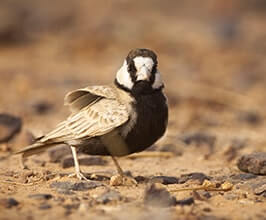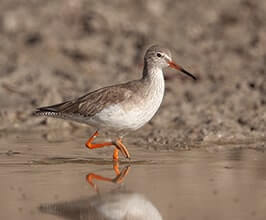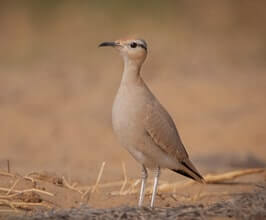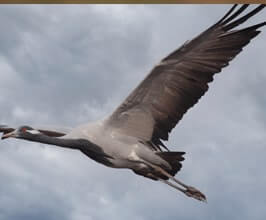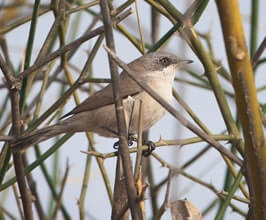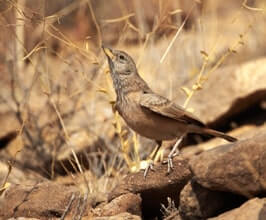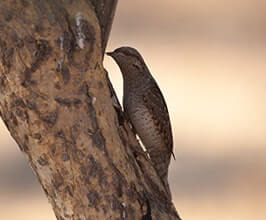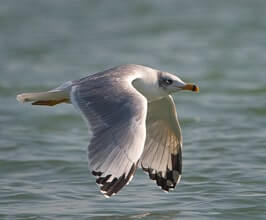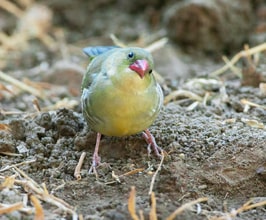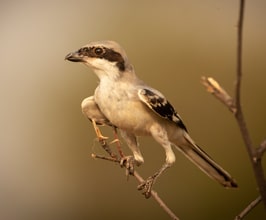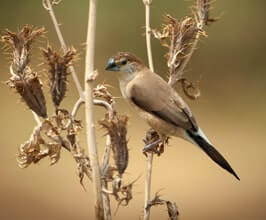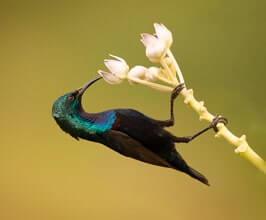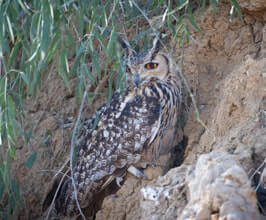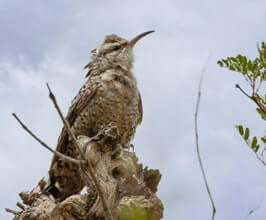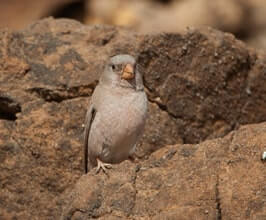Delhi – Udaipur – Mount Abu - Jodhpur – Jaisalmer - Desert National Park - Phalodi – Khichan – Tal Chhapar - Sambhar Wildlife Sanctuary - Ranthambore - Dholpur – Agra – Bharatpur - Keoladeo
15 Days / 14 Nights
Our Rajasthan birding tour offers a bouquet of extraordinary experiences. Besides covering the best birding trails of Rajasthan, the tour takes you on wildlife safaris More Info
Booked as per
request.
Included except arrival and departure city.

Private guide for complete tour.
Airport to Airport.
2-8PAX
Included
Our Rajasthan birding tour offers a bouquet of extraordinary experiences. Besides covering the best birding trails of Rajasthan, the tour takes you on wildlife safaris in tiger reserves, culture trips in rural Rajasthan, and a special visit to the Taj Mahal, one of the seven modern wonders of the world.
Birdwatching is the mainstay of our Rajasthan trip, and everything else hovers around it. Starting with a short warm-up birding tour in Delhi, we take you straight into the thick of action in South Rajasthan, to the popular hill station Mount Abu at the elevation of 1220 meters. A tourist hotspot, Mount Abu boasts a checklist of about 146 bird species, of which the rare Green Avadavat is certainly the prized sight.
From the Aravalli hills of Mount Abu, we move on to the desert sands of Jaisalmer on the westernmost frontier of India and scour the birding trails of Desert National Park in search of its main attraction, the Great Indian Bustard, apart from other avian specialties such as Black-bellied Sandgrouse, Spotted Sandgrouse, Barbary Falcon, Stoliczka’s Bushchat, Asian Desert Warbler, Trumpeter Finch, Cream-coloured Courser, Black-crowned Sparrow-Lark, Greater Short-toed Lark, Lesser Whitethroat, Common Babbler, Desert Wheatear, Chestnut-bellied Sandgrouse, Bay-backed Shrike, Pied Bushchat, and Variable Wheatear.
What makes Rajasthan one of the best birding hotspots of India is the presence, in large numbers, of several species of migratory birds that fly down from the colder regions of northern latitudes to the pleasant clime of west India every winter. And an important pitstop in this passageway is the village of Khichan, our next birding destination, where we get to see thousands of migratory Demoiselle Cranes.
Our Rajasthan birding adventure then heads east towards Tal Chappar Sanctuary, Sambhar Wildlife Sanctuary, Ranthambore National Park and Keoladeo National Park – all four great birding sites and each one different from the other in the bird sightings it offers.
Tal Chhapar’s biggest attraction is the raptors, especially the White-eyed Buzzards. Sambhar Wildlife Sanctuary centres around India’s largest salt lake and it hosts a wonderful cast of aquatic birds like Graylag Goose, Ruddy Shelduck, Northern Shoveler, Eurasian Wigeon, Green-winged Teal, Common Pochard, Greater Flamingo, Pied Avocet, Black-tailed Godwit, Pallas's Gull, Eurasian Marsh-Harrier, Indian Spot-billed Duck, Red-crested Pochard, Lesser Flamingo, Little Grebe, Great White Pelican, Painted Stork, Black-crowned Night-Heron, Lesser Whistling-Duck, Knob-billed Duck, Garganey, Ferruginous Duck, White-tailed Lapwing.
Ranthambore National Park is home to Bengal Tigers and we go on morning and afternoon jeep safaris in search of the striped predator and see a lot of birds while we’re at it. Keoladeo National Park is a thriving habitat of about 400 bird species and a good day of birding here yields a lot of them, including Indian Courser, Sociable Lapwing, Imperial Eagle, White-tailed Eagle, Greater Spotted Eagle, Indian Spotted Eagle, Dusky Eagle-Owl, Darters, Large-tailed Nightjar, Indian Nightjar, Grey Nightjar, Sarus Crane, Black-necked Stork, Painted Stork, Asian Openbill Storks, Common Pelican, Dalmatian Pelican, Black Bittern, Greater Painted Snipe, Marshall's Iora, Brook's Leaf Warbler and Siberian Rubythroat.
Our 16-day birding tour of Rajasthan covers all these destinations thoroughly and also packs in extra-curricular fun, such as a trip to a Rajasthan village, pit-stops at touristy Rajasthan cities, and a sightseeing tour of the Taj Mahal and the Agra Fort in neighbouring Uttar Pradesh. We at INDIA BIRDING TOURS are known to blend birding adventure with fun, and exploration with recreation like no other in the tourism industry. Our long experience of birding in Rajasthan reflects in our chockfull itinerary, which is drawn to extract maximum birding hours while making sure that you get to enjoy your India birding holiday to the full.
Lodging: Throughout our Rajasthan birdwatching tour, you get to stay at quality hotels and resorts, save for the two nights at a forest rest house at Tal Chhapar Sanctuary. The amenities at the rest house are basic, but the jungle experience it offers is quite special. It’s like putting up in the thick of a birding hotspot and having the liberty of watching the winged beauties even from your bedroom. At other places, the hotels and resorts are located close to the birding sites to add to your Rajasthan birdwatching experience.
Meals: You may be a vegetarian or a meat lover with preference for either Indian food or western food or both. We have it all covered. The hotels and resorts you stay in have a good variety of dishes on their menu. The meal choice may be a bit limited at the Tal Chhapar forest rest house, but the taste and hygiene are never compromised with. We even have our own kitchen staff, which may rustle up delicacies to your taste.
Tour Difficulty: Rajasthan birding holiday is quite easy on your body. Except the birding trails of Mount Abu, we don’t cover hilly areas for the most part of the tour. The terrain is mostly flat grassland, wetland, savanna, and forest. Having said that, you should be physically fit to put long hours in the field and be able to walk long distances while carrying your personal birding equipment such as binoculars, field guide, camera and backpack. Some days require long travel in cab from one Rajasthan birding destination to another.
Tour Extension: There are many tour-extension options to enrich your Rajasthan birding vacation. You may want to go on tiger safaris at Jim Corbett National Park in the mountains of Uttarakhand and also check out the birds of western Himalayas. Or you may simply want to visit some heritage sites in Rajasthan that are close to the birding trails. Such extensions can be arranged, provided you inform us well in advance.
Climate: Rajasthan can be quite hot in summers, but the monsoon period and the winter are the best times to visit. The winter here can be quite cold and you are advised to carry along woollen clothes and jackets for a tour around that time of year. The autumn and spring seasons are pleasantly warm and usual summer clothes are suited for a trip during these times. Also carry a raincoat for an odd shower.
India’s capital Delhi is where our Rajasthan birding tour begins. Our representative receives you at the airport or railway station in Delhi and drives you to a pre-booked hotel. After a short rest break, we take you out for a birding tour of Delhi.
A metropolis like Delhi may not come across as a birding destination at first glance, but the Okhla Bird Sanctuary, located at Okhla barrage on the outskirts of the city, quickly puts paid to such notions. As many as 300 bird species have been spotted here and our targets for the day include two endemic species, Striated Babbler and White-tailed Stonechat, besides several other birds such as Eurasian Collared-Dove, Laughing Dove, Yellow-footed Green-Pigeon, Greater Coucal, Asian Koel, Grey-headed Swamphen, White-breasted Waterhen, Black-winged Stilt, Red-wattled Lapwing, Pheasant-tailed Jacana, Temminck's Stint, Wood Sandpiper, Whiskered Tern, Oriental Darter, Great Cormorant, Indian Cormorant, Grey Heron, Cattle Egret, Indian Pond-Heron, Black-headed Ibis, Black Kite, Spotted Owlet, Indian Grey Hornbill, Common Kingfisher, Green Bee-eater, Brown-headed Barbet, Rose-ringed Parakeet, Black Drongo, Long-tailed Shrike, Ashy Prinia, Plain Prinia, Sykes's Warbler, Clamorous Reed Warbler, Plain Martin, Red-whiskered Bulbul, Indian White-eye, Rosy Starling, Bank Myna, India Robin, Oriental Magpie-Robin, Bluethroat, Pied Bushchat, Citrine Wagtail, Paddyfield Pipit, and Red-headed Bunting.
In the evening we return to our hotel for dinner and overnight. We sleep early because we have an early start the day after.
You take a morning flight from Delhi to Udaipur in Rajasthan. The flight usually takes an hour and a half. Upon your arrival in Udaipur, our representative meets you and drives you to Mount Abu, 164 km away. After a three-hour drive we arrive and check into a hotel and then head out for an evening birding tour of Mount Abu.
Mount Abu is the most popular hill station of Rajasthan. The green mountains of the Aravalli range here rise as high as 1722 meters. Owing to the lakes, rivers, waterfalls in this region of Rajasthan, which is mostly a desert state, Mount Abu is called an oasis in the desert. What many people don’t know is that it counts among the best birding hotspots of Rajasthan, with a checklist of about 146 bird species, of which the rare Green Avadavat is certainly the prized sight. During our birding tour of Mount Abu we also look out for Jungle Bush Quail, Gray Jungle Fowl, Yellow-footed Pigeon, Greater Coucal, Sirkeer Malkoha, Pied Cuckoo, Asian Koel, Common Hawk Cuckoo, Oriental Honey-buzzard, White-rumped Vulture, Indian Vulture, Crested Serpent-Eagle, Short-toed Snake-Eagle, Crested Hawk-Eagle, Booted Eagle, Tawny Eagle, Bonelli's Eagle, White-eyed Buzzard, Common Buzzard, Coppersmith Barbet, Brown-headed Barbet, Eurasian Wryneck and several others.
At night we return to our hotel in Mount Abu for dinner and overnight.
After breakfast we head out for a morning birding trip of Mount Abu and scour different birding trails than those of the previous day. We aim to tick off the missing birds in the checklist and return to the hotel by lunchtime. We then pack up and leave for the city of Jodhpur, which is about 260 km away and takes up 4 to 5 hours to reach.
Upon arrival in Jodhpur, we check into a hotel. You then have the option of spending the evening at leisure or going out for a short sightseeing tour of Jodhpur. If we make good time of our journey, we may find still open for public visit some of the biggest tourist attractions of Jodhpur, the most outstanding of which is the Mehrangarh Fort that overlooks the city from the height of a hill. Even if the touristy sites are closed by the time we arrive, there are still a lot of places to visit. The famous blue painted houses that give Jodhpur the nickname of ‘Blue City’, the bustling bazaars where you can do souvenir shopping, or the many restaurants offering the best of Rajasthani cuisine – you can easily while away the entire evening just exploring the city.
We overnight at the hotel in Jodhpur.
We have an early start to the day. After breakfast, we hit the highway to Jaisalmer, about 3-hr drive away. We arrive and check into a hotel in time to spare the whole of the day for birding at Jaisalmer, followed by another full day in the field.
Jaisalmer is a desert city on the western frontier of India. It’s famous for its namesake fort, and attracts thousands of tourists every year. Its arid landscape consisting of scrubland and desert doesn’t, at first glance, look like a great habitat for birds, but you may be surprised to learn that hundreds of bird species can be seen here, particularly at the nearby Desert National Park, one of the largest national parks in India. The biggest avian specialty of the park is the Great Indian Bustard, which is a subcontinental endemic. Alongside birding, we may also see interesting wildlife comprising of Chinkara, Blue Bull, Golden Jackal, Red Fox, Indian Fox, Desert Cat, Desert Hare, Black-naped Hare, and the Long-eared Hedgehog.
Over the course of our two days of Jaisalmer birding tour we target a lot of birds such as Black-bellied Sandgrouse, Spotted Sandgrouse, Barbary Falcon, Stoliczka’s Bushchat, Asian Desert Warbler, Trumpeter Finch, Cream-coloured Courser, Red-headed Vulture, Cinereous Vulture, Eurasian Griffon, Short-toed Snake-Eagle, Tawny Eagle, Pallid Harrier, Long-legged Buzzard, Green Bee-eater, Eurasian Kestrel, Laggar Falcon, Black-crowned Sparrow-Lark, Greater Short-toed Lark, Lesser Whitethroat, Common Babbler, Desert Wheatear, Chestnut-bellied Sandgrouse, Bay-backed Shrike, Pied Bushchat, Variable Wheatear, Tawny Pipit, Shikra, Dusky Crag-Martin, Sykes's Nightjar, Rufous-fronted Prinia, Lesser Whitethroat, Eastern Orphean Warbler, Indian Robin, Indian Silverbill, White-capped Bunting, Gray-necked Bunting, and Striolated Bunting.
We overnight at hotel in Jaisalmer and may even explore its bazaars at night.
After an early morning coffee, we go out for a birding tour around Jaisalmer and, having marked off the missing birds in the checklist, we return to our hotel, have our breakfast and hit the road to Phalodi. The drive takes us about 4 hours and we check into a hotel upon our arrival in Phalodi.
Geographically, Phalodi is located in what is called the buffer zone of the Thar desert. It is also known as the salt city because of its thriving salt industry. Phalodi has a rich historical heritage and one can still find ancient havelis and temples here. From the birding perspective, the city and the area around it are famous for sightings of migratory cranes, which are locally called Kurja. Phalodi is located in the heartland of rural Rajasthan. In the evening, we may go out for a culture trip to a nearby village. The people here are hospitable, and they have a strong sense of honour. Tradition and age-old customs are still deeply rooted in their lives.
After spending quality time at the village, we return to our hotel in Phalodi for dinner and overnight.
Just 4 km away from Phalodi is the village of Khichan, which has, over the years, acquired reputation for being the wintering ground of tens of thousands of migrating demoiselle cranes. There is a short history behind the rise of Khichan as a famous birding hotspot of Rajasthan. The tale goes that back in the 1970s a local here started feeding pigeons. Over time, other villagers joined in and the village became a stopover point for demoiselle cranes. Presently, as many as 20,000 of these avian beauties can be seen at Khichan every winter.
The morning hours of the day are dedicated to birding at Khichan, after which we hit the road for a 4-hour drive to the Tal Chhapar Sanctuary. Upon our arrival we check into a forest rest house and go out for a India Short Birding Tours of Tal Chhapar, which is a sprawling grassland with scrubby vegetation and tropical forest. The sanctuary is dedicated to conserving the Blackbuck, Desert Hare, Blue Bull and Chinkara, but it lies on the winter passage of thousands of migratory birds from the colder northern regions. Birds of thorn forests, raptors, and vagrants can be seen here in large numbers.
After our half-day Tal Chhapar birding tour, we return to the forest rest house for dinner and overnight.
Tal Chhapar Sanctuary is located on the edge of the great Indian desert. Every winter thousands of birders, photographers, nature lovers and vacationers visit the sanctuary to see birds in large numbers. The vegetation here has the appearance of savanna, giving the birders a clear and unobstructed view of several migratory avian specialities.
Raptors are the biggest attraction of Tal Chhapar. Our bird targets for the day include White-eyed Buzzards, White-tailed Eagle, Spotted-Creeper, Red Phalarope, Yellow-eyed Pigeon, Eastern Imperial Eagle, Water Pipit, Red-necked Falcon, Black-bellied Sandgrouse, White-browed Bushchat, Eurasian Skylark, Merlin, Sociable Lapwing, Blue-cheeked Bee-eater, Laggar Falcon, Demoiselle Crane, Rain Quail, European Roller, Bonelli's Eagle, Eurasian Griffon, Bimaculated Lark, Cinereous Vulture, Spanish Sparrow, Punjab Raven, Variable Wheatear, Southern Grey Shrike, Desert Wheatear, Lesser Whitethroats, Common Babbler, Greater Short-toed Larks, Eurasian Kestrel, Isabelline Wheatear and many more. If luck holds, we may even see herds of blackbuck.
After a fruitful day of birdwatching at Tal Chhapar Sanctuary, we retire to our forest rest house in the evening for dinner and overnight.
We have a long drive of 400 km from Tal Chhapar to Ranthambore ahead of us. So, we leave early in the morning and drive in south-easterly direction, passing through the city of Jaipur.
On the way, we take a break from our journey at Sambhar Wildlife Sanctuary, just 80 km south of Jaipur. Named after India’s largest salt lake (Sambhar Salt Lake), the sanctuary is a designated Ramsar Site for being the wintering ground of tens of thousands of migratory birds coming down from the colder regions of Siberia and North Asia. During our break, we do a birding tour of Sambhar Wildlife Sanctuary and look for the likes of Graylag Goose, Ruddy Shelduck, Northern Shoveler, Eurasian Wigeon, Green-winged Teal, Common Pochard, Greater Flamingo, Pied Avocet, Black-tailed Godwit, Pallas's Gull, Eurasian Marsh-Harrier, Long-legged Buzzard, Peregrine Falcon, White-bellied Minivet, Gadwall, Indian Spot-billed Duck, Northern Pintail, Red-crested Pochard, Lesser Flamingo, Little Grebe, Kentish Plover, Great White Pelican, Painted Stork, Black-crowned Night-Heron, Lesser Whistling-Duck, Knob-billed Duck, Garganey, Ferruginous Duck, White-tailed Lapwing, Temminck's Stint, Black-headed Gull, and Gull-billed Tern, among others.
After this birding excursion we resume our journey to Ranthambore. We arrive at our destination in the evening and check into a hotel for dinner and overnight.
Two wildlife safaris, one in the morning, another in the evening are scheduled for the day at Ranthambore National Park, one of the largest wildlife sanctuaries in India. The Bengal Tiger is the park’s chief attraction, but thousands of tourists are drawn to this biodiversity hotspot to see other wildlife, such as Indian leopard, striped hyena, nilgai, wild boar, sambar, chital, rhesus macaque, and mugger crocodile. The park is also one of the best birding destinations of North India.
Hundreds of bird species can be spotted at the park, but our birding expedition of Ranthambore focusses particularly on Indian Pitta, Shikra, Painted Spurfowl, Painted Sand-grouse, White-rumped Flameback, Indian Golden Oriole, Great Tit, Crested Bunting, Common Tailor Bird, Paradise Flycatcher, Rose-ringed Parakeet, Painted Stork, Lesser Whistling Duck, Little Cormorant, White-breasted Waterhen, apart from several others. We catch sight of these avian beauties in the morning and afternoon jeep safaris. As the park is spread out over a very wide area of 1334 sq km, it helps to be mobile to tick off a great many birds in the checklist.
After the jeep safaris at Ranthambore we return to our resort for dinner and overnight.
The areas around Ranthambore National Park have a great deal of birding potential. There is Padam Talao, the largest of the many lakes in the park where one may see a lot of aquatic birds. There are grasslands, meadows, and lush woods that host several interesting bird species of North India. There are villages close by that, apart from a birding session, also make for a culture trip of rural Rajasthan.
After breakfast at the resort, we set out to scour these areas and look for birds like Black Francolin, Painted Francolin, Grey Francolin, Common Quail, Rain Quail, Blue-breasted Quail, Jungle Bush Quail, Rock Bush Quail, Painted Spurfowl, Indian Peafowl, Lesser Whistling Duck, Greylag Goose, Bar-headed Goose, Ruddy Shelduck, Common Shelduck, Comb Duck, Cotton Pygmy Goose, Gadwall, Eurasian Wigeon, Mallard, Spot-billed Duck, Common Teal, Garganey, Northern Pintail, Northern Shoveller, Red-crested Pochard, Common Pochard, Ferruginous Pochard, Tufted Duck, Small Button Quail, Yellow-legged Buttonquails, Barred Buttonquails, Eurasian Wryneck, Brown-capped Pygmy Woodpecker, Yellow-crowned Woodpecker, Black-rumped Flameback, White-naped Woodpecker, Brown-headed Barbet, Coppersmith Barbet, Indian Courser, etc.
After a busy day of birding at Ranthambore, we retire to our resort for dinner and overnight.
We hit the northward road from Ranthambore to Bharatpur right after breakfast. A four-hour journey on a metalled road cutting through rural Rajasthan takes us to Bharatpur, which is home to Keoladeo National Park, previously known as Bharatpur Bird Sanctuary.
Keoladeo is often hailed as one of the best birding hotspots in the world. An acknowledged World Heritage Site, Keoladeo National Park hosts about 400 bird species, including several wintering migratory birds, especially waterfowls. The park’s geography comprising of dry grasslands, wetlands, swamps and scrubs make it a thriving avian habitat. Every year, thousands of birders and ornithologists visit Keoladeo to see and photograph hundreds of birds. A good day of birding at Keoladeo National Park can yield up to 150 bird species, if not more. The prized sightings include Indian Courser, Sociable Lapwing, Imperial Eagle, White-tailed Eagle, Greater Spotted Eagle, Indian Spotted Eagle, Dusky Eagle-Owl, Darters, Large-tailed Nightjar, Indian Nightjar, Grey Nightjar, Sarus Crane, Demoiselle Crane, Black-necked Stork, Painted Stork, Asian Openbill Storks, Common Pelican, Dalmatian Pelican, Black Bittern, Greater Painted Snipe, Marshall's Iora, Brook's Leaf Warbler and Siberian Rubythroat.
Upon our arrival in Bharatpur, we check into a resort and go birdwatching at Keoladeo National Park. We return in the evening for dinner and overnight.
Keoladeo covers an area of 29 square kilometres and has several birding trails worth exploring. After breakfast, we head out for another birding tour of Keoladeo National Park, but this time we cover different areas to seek out newer avian specialties.
Our target birds for the day include raptors such as Egyptian Vulture, White-rumped Vulture, Indian Vulture, Red-headed Vulture, Eurasian Marsh Harrier, Shikra, Indian Spotted Eagle, Greater Spotted Eagle, Tawny Eagle, Steppe Eagle, Imperial Eagle, Bonelli’s Eagle, Booted Eagle, Common Kestrel and Peregrine Falcon. A birding session along the wetlands of Keoladeo reveals the likes of Bar-headed Goose, Ruddy Shelduck, Comb Duck Egrets, Red-crested Pochard, Ferruginous Pochard, Painted Stork, Open-billed Stork, Cormorants, Darters, Ibises, Spoonbills, Black-tailed Godwit, Eurasian Curlew, Cotton Pygmy-Goose, Spot-billed Duck. We also scour the woods to look for Spotted Redshank, Wood Sandpiper, Little and Temminck’s Stints, Ruff, Little-ringed and Kentish Plovers, and White-tailed Lapwing. Persevering birders may even be rewarded with a rare sight of Sociable Lapwing.
We dedicate the whole day to our birding adventure at Keoladeo. On a good day, it’s possible to tick off a hundred or more bird species. We return to our resort in the evening for dinner and overnight.
After breakfast, we head out for a 2-hour cab ride from Bharatpur to Dholpur, about 90 km away. Our focus is on the river Chambal and the adjoining National Chambal Sanctuary, which hosts around 250 species of resident and migratory birds of North India.
The Chambal river originates in the Vindhya mountains of Madhya Pradesh in central India, from where it flows first in the north-westerly direction into Rajasthan and then towards southeast into Uttar Pradesh. Though the river’s course through Rajasthan isn’t long, its passage through Dholpur attracts a lot of avian species, and it’s this birding area of Chambal National Park we target. The most sought-after bird here is the Indian Skimmer, but there are a lot of other winged beauties to watch and photograph. The checklist includes Indian Courser, Black-bellied Terns, Great Thick-knee, Red-crested Pochard, Ferruginous Pochard, Sarus Crane, Bar-headed Goose, Pallas's Fish Eagle, Pallid Harrier, Greater and Lesser Flamingos, Darters, Gull-billed Tern, River Tern, Little Tern, Black-bellied Tern, Whiskered Tern, White-winged Tern and several others.
Chambal also reveals an interesting variety of wildlife such as Gharials, Marsh Crocodiles, Gangetic Dolphins, Striped Hyenas and Wolves. After a full day’s birding at Chambal, we return to our resort in Dholpur for dinner and overnight.
Halfway into our North India birdwatching holiday comes one of the many highlights of this trip: a visit to the Taj Mahal. We leave Dholpur after breakfast and drive northwards to the city of Agra. The cab ride takes about 2 hours and we reach in time to do an afternoon tour of the Taj Mahal and the Agra Fort.
Officially acknowledged as one of the seven wonders of the world, the Taj Mahal attracts millions of tourists every year. It was built in the 17th century by the Mughal emperor Shah Jahan in memory of his dead wife Mumtaz Mahal, and is rightly called the monument of love. The Taj Mahal epitomizes the sublime art and architecture of the Mughal empire. The majestic layout of the monument and the works of intricate carving and stonemasonry on the tiles, panels, apses, domes, windows and vaults are of the highest imagination and quality ever seen.
Just 2.5 kilometres away is the Agra Fort, which is more ancient than the Taj. It is a sprawling structure and used to be the residence of former Mughal kings, but is now a popular tourist destination of Agra. We do an elaborate tour of the fort and then leave for Delhi. A 4-hr drive takes us back to India’s capital. We overnight at a hotel in Delhi.
In the morning, we drop you at the Delhi airport for your onward journey. The Rajasthan birding tour comes to an end.
